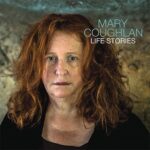 It’s no surprise that “Life Stories” is autobiographical; the title is a bit of a giveaway. Mary Coughlan’s renowned for her unflinching honesty and this album has its painfully candid moments, but there’s a healthy seasoning of musical and lyrical humour for contrast. I’m using autobiographical a bit loosely here; there are a few interpretations in addition to Mary’s co-writes, but they’re all carefully chosen to fit in with the overall themes of the album.
It’s no surprise that “Life Stories” is autobiographical; the title is a bit of a giveaway. Mary Coughlan’s renowned for her unflinching honesty and this album has its painfully candid moments, but there’s a healthy seasoning of musical and lyrical humour for contrast. I’m using autobiographical a bit loosely here; there are a few interpretations in addition to Mary’s co-writes, but they’re all carefully chosen to fit in with the overall themes of the album.
A perfect example is the album’s opener “Family Life” which touches on dysfunctional families and religion. It’s obvious from the first few bars that it’s a Blue Nile (Paul Buchanan) song but Mary’s incredible voice immediately marks it as her own. And that voice; the obvious and over-used comparison is Billie Holiday, but it’s still valid. The richness and resonance of Mary’s voice and the exquisite phrasing are the magic ingredients that bring the songs to life. That and the quality of the musicians and arrangements. The band moves seamlessly between the slow ballad stylings of “Elbow Deep” and “No Jericho” the swing of “High Heel Boots” and “Forward Bound”, and the sixties chanteuse pop of “Two Breaking Into One” as the album ebbs and flows on its journey. The only aim of the band is to serve the song and to give Mary the best setting for her potent vocal delivery.
Although Mary has the reputation of being harrowingly honest, there’s also a lot of humour running through the album. “High Heel Shoes” hints at “These Boots Were Made for Walking” and the late Kirsty MacColl’s fabulous “In These Shoes”, while George Gershwin’s “Do It Again” is given a cheeky intro with the very short Cole Porter pastiche “Little Dance”. And the album’s closing song “Twelve Steps Forward, Ten Steps Back” takes a humorous swipe at the addiction recovery process. I want to read a positive approach into it because there’s a gain of two steps. The slow ballad “Safe and Sound” also shines a positive light contrasting Mary’s troubled past with the love she feels for her own children and grand-children.
Two of the darker songs on the are interpretations of songs by other Irish writers. “Elbow Deep” is a Karrie O’Sullivan song about the young Irish women abandoned by their families after indiscretions and “No Jericho” is a Susan McKeown song, stripped back to a slow piano and upright bass arrangement that leaves plenty of space for an intimate vocal interpretation.
“Life Stories” is one of the best albums I’ve heard this year. It’s a journey from pessimism to optimism with occasional flashbacks and doesn’t ignore the fact that even the most horrific journeys can have their humorous twists and turns. It’s a fine set of musicians creating settings that make these twelve diamonds sparkle.
“Life Stories” is released in the UK on Friday September 4th on Hail Mary Records (HM002CD).
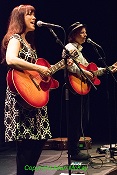 Just before the end of their recent twentieth anniversary tour of the UK, I was lucky enough to chat to Pete and Maura Kennedy at Kings Place in London just after their soundcheck. We talked about how they met, songwriting, technology and a whole lot more. Here’s how it went:
Just before the end of their recent twentieth anniversary tour of the UK, I was lucky enough to chat to Pete and Maura Kennedy at Kings Place in London just after their soundcheck. We talked about how they met, songwriting, technology and a whole lot more. Here’s how it went:
Allan – So, twenty years together this year. I’ve heard the story but I’m sure Music Riot readers will love it. Could you tell them the story of how you met?
Pete – Well, that happened down in Austin, Texas and we always say that the only trouble with Austin is that it’s surrounded by the rest of Texas, because it’s very much a college town and not typical of the American South at all but it’s a very rock ‘n’ roll and folk and songwriter-oriented town. There’s a place called The Continental Club which is the roots music Mecca of America; I was doing a gig there and that’s where the two of us met. First we talked about music, we didn’t actually play or sing and we then met up a day later at a little songwriters gathering and when we did sing together we found out that we loved each other’s songs and we had a bit of a harmony blend and so we started writing but I had to leave right away and play with Nanci Griffith up at Telluride, Colorado. I drove up there through the desert and into The Rockies and I called Maura after the show and we really wanted to get back together. We were talking on the phone and we decided that since we both knew that we loved Buddy Holly, we would meet at the equidistant point between Austin, Texas and Telluride, Colorado and it was Lubbock, Texas which is where Buddy Holly’s from and he’s buried there. We each drove five hundred miles solo with no cellphones, so we didn’t really know that the other person was doing this and we met at Buddy Holly’s grave and we’ve really been together ever since because very shortly after that, Nanci Griffith needed another band member, a female singer to do harmonies and Maura stepped right into that role and so we’ve been working together steadily ever since we first met.
Maura – And when we left for that tour, we were both in her band but, at the airport, she told us we were going to be her support act for that tour, back in 1993, and we’d only written that one song, we didn’t have an act worked up but we didn’t tell her any of this because we didn’t want to blow that opportunity so we bluffed our way through the first couple of gigs.
Pete – The Southport Theatre was the first gig.
Maura – And by the end of the tour we had our first album’s worth of songs.
Allan – That is a great story.
Pete – We always acknowledge Buddy Holly as our patron saint…
Maura – And Nanci Griffith as the bird that pushed the little chickadees out of the nest.
Pete – She was our mentor: no doubt.
Allan – The first time I saw you was actually in this venue two years ago and that year you had one album out, last year between you, you had two albums out, this year it’s three albums. By anyone’s standards that’s pretty good going, so what can you tell me about the three albums?
Maura – For some reason, both of us were on a real writing spree over the last six to eight months and we were both writing together, both writing independently and gathering songs and it was apparent that we had more songs than we needed for one album, but it also looked pretty obvious how the songs would divide up. The songs we were writing together would be on The Kennedys album, which is called “West”, and that came out last month. Then I was working with a published poet out in California; he provided me with all these lyrics that he wrote specifically for me to write music to and these had a different quality so we decided to have all those solo songs on my album “Villanelle”, which is coming out next week. Meanwhile Pete has been working on this, I think it’s his masterpiece, he’s been working on these songs a good five years. It’s a cycle of songs set in New York City and he sings on these. People are used to him releasing instrumental albums but this is a really cool rock ‘n’ roll album and it’s called “The Heart of Gotham” and that’s coming out in June. So rather than take the twentieth anniversary as a moment to look back we charged straight ahead.
Allan – So apart from having three albums of new material, over the years, how do you keep the live shows fresh?
Maura – Oh, that’s easy. For the past few years we’ve been doing all-request shows. Now we’ve got all this new material and we’re playing a lot of that but three albums is more than you can do in one show, so we’re mixing that up and playing a lot of new material this time. We always get people who have come to our shows before and they have requests so we try to honour as many of those as we can but the shows in the past four or five years have been really audience-driven and that keeps it fresh for the ones who come back to more than one show a year and it keeps it really fresh for us; we have to stay on our toes to remember all those songs.
Pete – We literally go through the audience right before the show and write down what people want to hear and that’s the setlist for that night, so every show is different. Right now we’re not doing that format because we have so many new songs we want to introduce those to the audience.
Maura – Although we have been getting some requests and last night we got requests for songs we haven’t played in a very long time, so we were brave and played them and it was fun.
Allan – That’s very like the New Jersey bands, Springsteen and Southside Johnny, they rely a lot on feedback from the audience and the musicians are good enough to do it as well.
Pete – I think because they came up playing in clubs and bars, and there you better play what people want to hear or they’ll throw things at you so you get used to pleasing the crowds, so to speak, and we’re lucky because, and I’m sure Bruce and Southside feel the same way, we have fans who know all our songs and they’ll ask for different songs from our catalogue so we can resurrect those.
Maura – I think maybe a lot of bands will get people who come out and see them once or twice; we have a lot of fans that come to every show that they can and so, to keep it fresh for them, it was a deliberate decision to make it audience-driven, for them more than anything else. It’s good for us too, but it was really to keep them coming back.
Allan – When I looked the twentieth anniversary thing, I looked back to 1995 and I thought that so many things have changed since that period in the music business…
Maura – In the world…
Allan – How have you reacted to the changes that have happened in the music business? Do you think it’s helped or hindered you?
Maura – There are so many different aspects to it. I remember when our very first album came out, “River of Fallen Stars”, it was on the very first Americana chart, there wasn’t such a thing before and nobody really knew what Americana was. At that time, independent artists really had a wide-open doorway into the music industry; radio stations were playing our stuff and there was very varied radio across the United States and I think that was probably true here too, and then things tightened up. The digital thing has really been difficult for a lot of people and I’m sure that our record sales in the traditional outlets are not as healthy as when we started but our audience, the baby boomers largely, are a segment of the population that has always valued music and they consider themselves to be patrons of the arts, so they come to shows and they buy records form us. In fact, I’ve often had people say: ‘How do you make more money, if I buy it from Amazon or from you?’ and they really want to know. I don’t know what we’d do without them, but we’re baby boomers too and we have the same outlook as far as the value of music is concerned.
Allan – It’s certainly my experience that most of the bands I see now aren’t really making any money out of record sales so people feel they have to buy a CD or t-shirt at the gig so that something goes back to the people that are making the music.
Pete – Record shops don’t really exist, in The States anyway, so it’s not like you’d put out a record and you sit back and wait for cheques to roll in (which never happened to us anyway) but that’s not a paradigm that even exists any more, so you really have to be playing gigs, which is OK, it’s been like that ever since the first cavemen were banging on rocks. They went out and played gigs and people gave them vegetables or whatever and this is basically that same system.
Allan – You seem to have embraced the social media side of things as well. I suspect that works well for you.
Maura – When we first started we had a mailing list and we would put stamps on and stick things in the mail and it was very expensive – it would cost about a thousand dollars to send out one mailer. One really good aspect of the digital world is that we’re able to contact our fans directly at no cost and what happened over the years is that we went from just putting out an electronic newsletter to embracing a number of social media outlets, not all of them, but the ones our fans use, Twitter and Facebook and I think what’s really important, and it’s worked for us, is to take a multi-pronged approach and get the word out in all the different realms. That way you’ll get a couple of people here, a couple of people there; it’s still word of mouth for us, it’s just that it’s digital now.
Allan – I can certainly see with your fans that social media enables you to create a community. It’s not so much artist and audience it’s everybody in it together.
Maura – People post photos and videos and they make song requests via social media and so they really do feel a part of it. One thing I do a lot if we’re coming to a town and ticket sales might not be as robust as we’d like, I’ll say ‘Hey guys, tell your friends we could really use your help on this show and we’ll love you forever’. And I find people really want to help; they do get the word out, they share that information and they really have a hand in helping us in more ways than just buying tickets and records.
Allan – It struck that your music seems to cross an awful lot of boundaries. How would you define it and who would you say has influenced you, apart from Buddy Holly?
Pete – Maura mentioned that we were on the first Americana chart and when we saw that we immediately had our own definition of Americana. A different one developed that was sort twangy, honky-tonk country and was restricted to just that and we never felt that was the entire breadth of American music. We do that stuff, our song “West” is a twangy country song because we love Gram and Emmylou and Buck Owens and Merle Haggard and stuff like that, but we don’t restrict ourselves to that at all. So we include George Gershwin and soul and jazz – that’s one of the great American art forms along with blues and rock ‘n’ roll and gospel; those things are all tied in together so Americana encompasses all of that stuff. Even “Closer Than You Know” has a kind of impressionistic feel to it and that’s Duke Ellington and Billy Strayhorn who were very heavily influenced by French Impressionism, so that brings that in too. Someone said the other day ‘You play a little Spanish sometimes’ and I said ‘Well, if you go down to the border of Texas, that’s the way people play down there’. So we’re trying to cover the entire geography because that’s what we do in our car and we try to do it musically too. We have the broadest possible definition of Americana.
Allan – Do you have a particular method of writing that you always use?
Maura – No, and that’s a real blessing; because we write in different ways, the music evolves over time. Our very first songs that we wrote together, “Day In and Day Out” was the very first song we wrote together, Pete gave me the title and I sang the title back to him and we wrote everything, music and words, together. The second song that we wrote together was “River of Fallen Stars” and he gave me an entire lyric sheet and I put a melody to that. On the album “Closer than You Know”, for a lot of those songs, Pete had recorded instrumental tracks with form but no melody and no words and I would put the whole song to that. On my new record, “Villanelle”, these are all lyrics that were sent to me by this poet B.D. Love and they’re in poem forms, forms I would never write in, so I’m trying to stay very true to the poetic forms and still make them sound like songs. Pete will sometimes write music first and sometimes lyrics, so we mix it all up. We try to not fall into a formula.
Allan – And what will the future bring? Next year four albums?
Maura – That’s a good question. We never know but we’re always really open and we always try and go with the flow. If you had asked us that question twelve months ago we wouldn’t have known we had three albums coming out; that came together in the last nine or ten months. So we don’t know but I’m sure it’ll be fun.
Allan – One last question. Do you have a song that makes you cry?
Maura – I’ve cried a lot singing songs. “When I Go” by Dave Carter is one of them. They change all the time. “I’ll Come Over” is a good example; that’s a song to my best friend and if I know somebody’s having trouble, I’ll dedicate it to them. I’ll start singing it and I’ll start crying; songs like that I can’t even talk about. And unfortunately, that was all we had time for before Pete and Maura had to get ready to go out and do their thing.
“West” and “Villanelle” are out now and “The Heart of Gotham” is out in June.
 There’s a part of me that wants to always see The Kennedys (and a lot of other very talented artists) playing in small intimate venues like Green Note where the atmosphere is friendly, intimate and respectful and both performers and audience both have a good time. There’s a larger part which wonders why they aren’t playing to much bigger audiences and achieving wider recognition. I guess it’s about fashion rather than talent, but so many people are missing out on a wonderful music experience. It’s not about turning everything up to eleven and relying on lots of technology; you can get that at The Dublin Castle, and it’s closer to the Tube station. It’s about beautiful voices, gifted playing and a rapport between performers and audience.
There’s a part of me that wants to always see The Kennedys (and a lot of other very talented artists) playing in small intimate venues like Green Note where the atmosphere is friendly, intimate and respectful and both performers and audience both have a good time. There’s a larger part which wonders why they aren’t playing to much bigger audiences and achieving wider recognition. I guess it’s about fashion rather than talent, but so many people are missing out on a wonderful music experience. It’s not about turning everything up to eleven and relying on lots of technology; you can get that at The Dublin Castle, and it’s closer to the Tube station. It’s about beautiful voices, gifted playing and a rapport between performers and audience.
This is the second time I’ve seen The Kennedys and this time they’re approaching the end of a tour celebrating the work of their good friend and collaborator, Nanci Griffith; Edwina Hayes is also there to add another guitar and another layer of harmony but before that, there’s the support band – The Kennedys, playing a set of their own material (all chosen by the audience) including “Breathe”, “Half a Million Miles”, “I’ll Come Over”, “9th Street Billy” and Pete’s awe-inspiring ukulele rendition of “Rhapsody in Blue”; I mean, Gershwin on a uke, what more could you want? As ever, Maura’s vocals are perfect with even a hint of Joni Mitchell that I’d never noticed before and Pete’s harmonies are spot on. It’s amazing the kind of stew you can cook up with two guitars and two voices, when you know the recipe.
For the Nanci Griffith set, Pete and Maura are joined by Edwina Hayes who helps to produce some stunning three-part harmonies which, at times, are hairs-standing-on-the-back-of-the-neck good. Edwina has also toured with Nanci, who covered “Pour Me a Drink”, the title track of Edwina’s second album. The next hour passes in what seems like five minutes as the trio rattle through a set which includes “Pour Me a Drink” (of course), “Trouble in the Fields”, “Across the Great Divide”, “I’m Not Driving these Wheels”, “From a Distance” and “There’s a Light Beyond the Woods (Mary Margaret)”. The three voices work perfectly together throughout the set and the audience is spellbound; no-one’s talking about their terrible journey of the Tube or checking their phone and I even feel a bit guilty about the noise of my camera shutter in a couple of the quieter moments. It’s a superb set from three gifted musicians who obviously love the songs they’re playing; I don’t think you can ask for anything more.
You can still see The Kennedys on Friday June 13 at The Quay Theatre in Sudbury, Saturday June 14 at The Grayshott Folk Club and Sunday June 15 at The Kitchen Garden Café in Birmingham. You can also get Pete or Maura to sell you “Tone, Twang and Taste” (Pete’s solo instrumental CD) and “Dance a Little Closer”, a live recording from New York of the Nanci Griffith interpretations. Go out and see them; you’ll have a great time.
I love this; it’s time for the High Fives again and it’s a very different challenge this year with my live selections. I had to work really hard to bring this down to just five gigs, but I think this just about sums it up. In no particular order, here they are.
The Kennedys @Kings Place
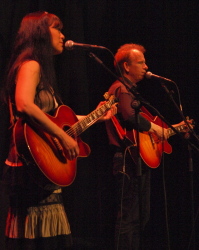 This was one of the many venues I visited for the first time this year and it was a perfect place to see Pete and Maura Kennedy live proving that you can create musical perfection with just two guitars and two voices. As well as having a stack of their own songs to create a set from (with plenty of input from the audience) they very generously feature songs by other writers and give the audience plenty of background about the songs and writers as well. I know you’ll find this difficult to believe, but they also did something that left me speechless; Pete played a ukulele version of George Gershwin’s “Rhapsody in Blue” which was stunning. And I got to hear a live version of “Big Star Song” which had been impossible to get out of my head after reviewing the album. And they are two genuinely lovely people.
This was one of the many venues I visited for the first time this year and it was a perfect place to see Pete and Maura Kennedy live proving that you can create musical perfection with just two guitars and two voices. As well as having a stack of their own songs to create a set from (with plenty of input from the audience) they very generously feature songs by other writers and give the audience plenty of background about the songs and writers as well. I know you’ll find this difficult to believe, but they also did something that left me speechless; Pete played a ukulele version of George Gershwin’s “Rhapsody in Blue” which was stunning. And I got to hear a live version of “Big Star Song” which had been impossible to get out of my head after reviewing the album. And they are two genuinely lovely people.
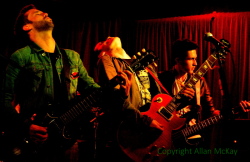 Federal Charm and Southside Johnny @The Apex, Bury St Edmunds
Federal Charm and Southside Johnny @The Apex, Bury St Edmunds
Predictable, me? The truth is, I’ve seen Southside Johnny and the Asbury Jukes dozens of times and I’ve never seen a bad gig. I’ve also never seen anything resembling the same set twice. But I’m getting ahead of myself. We got to the venue just as the support band, Federal Charm, were starting their set and the impact was instant; frontmen Nick Bowden and Paul Bowe trading riffs and solos under Nick’s incredibly powerful lead vocal. They’ve got self-assurance by the bucketload and a bunch of great songs as well. And that was just the support act. Southside Johnny, surrounded by a bunch of Jukes that have been playing as a unit for a few years now, looked more relaxed than I’ve seen him in years and sounded better than ever. They played a set that wasn’t too reliant on the old classics, but was still appreciated by the old fans. As always, the audience (and most of the band) had no idea where the set was going next and we loved it.
Dean Owens @The Cabbage Patch, Twickenham
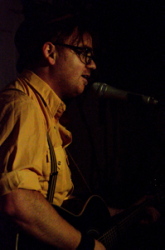 You might have noticed that the Riot Squad are big fans of Dean Owens. We’ve been telling you about his albums for a couple of years now but, living in London, it’s a bit of a challenge seeing a live show; luckily we like a challenge and the first one was getting the squad from various parts of London and the south-east to Twickenham on a Friday evening. When we finally made it, the venue was perfect; intimate with a nice sound system and a very appreciative audience. Ags Connolly (whose debut album on Drumfire Records was produced by Dean) opened the show with a strong bunch of songs before Dean delivered a great set built around the “Cash Back” album with loads of songs from earlier albums and audience requests thrown in. It’s worth adding that Dean has a very dry sense of humour and the audience interaction between songs was great fun as well. Top night and many thanks to Phil Penman and Drumfire for keeping the faith.
You might have noticed that the Riot Squad are big fans of Dean Owens. We’ve been telling you about his albums for a couple of years now but, living in London, it’s a bit of a challenge seeing a live show; luckily we like a challenge and the first one was getting the squad from various parts of London and the south-east to Twickenham on a Friday evening. When we finally made it, the venue was perfect; intimate with a nice sound system and a very appreciative audience. Ags Connolly (whose debut album on Drumfire Records was produced by Dean) opened the show with a strong bunch of songs before Dean delivered a great set built around the “Cash Back” album with loads of songs from earlier albums and audience requests thrown in. It’s worth adding that Dean has a very dry sense of humour and the audience interaction between songs was great fun as well. Top night and many thanks to Phil Penman and Drumfire for keeping the faith.
Marcus Bonfanti
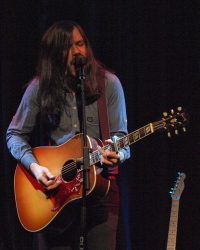 Marcus Bonfanti is the British blues equivalent of the Duracell bunny; he never stops working. During 2013, he released an album and did a solo acoustic tour and a full band tour to promote the album. I was lucky enough to see an acoustic show (in the unlikely environment of a casino in the West End) and a full band show in The Borderline. Both gigs were excellent and Marcus is a superb blues player and singer with a great line in self-deprecatory chat and humour between songs. The highlight of each set was the wonderful “The Bittersweet”, one of the best new songs from any genre I’ve heard this year. All of the songs are so strong that they worked perfectly in a solo setting and with the full band; spot on musically and great fun as well.
Marcus Bonfanti is the British blues equivalent of the Duracell bunny; he never stops working. During 2013, he released an album and did a solo acoustic tour and a full band tour to promote the album. I was lucky enough to see an acoustic show (in the unlikely environment of a casino in the West End) and a full band show in The Borderline. Both gigs were excellent and Marcus is a superb blues player and singer with a great line in self-deprecatory chat and humour between songs. The highlight of each set was the wonderful “The Bittersweet”, one of the best new songs from any genre I’ve heard this year. All of the songs are so strong that they worked perfectly in a solo setting and with the full band; spot on musically and great fun as well.
Carrie Rodriguez @The Old Queen’s Head, Islington
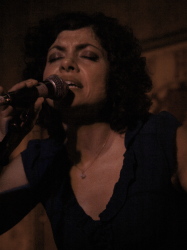 Yet another venue that I haven’t visited before; this is a room above a pub with a capacity of about eighty. Yet again, the sound system was spot-on and the audience were very appreciative as Carrie, accompanied by Luke Jacobs (and playing between them fiddle, tenor guitar, acoustic and electric guitars and lap steel) rattled through two sets of songs taken mainly from her current album, “Give Me All You Got”, with some old favourites thrown in as well. The songs were very high quality, the playing and vocals were superb, and Carrie and Luke’s easy relationship with the audience made this a superb night.
Yet another venue that I haven’t visited before; this is a room above a pub with a capacity of about eighty. Yet again, the sound system was spot-on and the audience were very appreciative as Carrie, accompanied by Luke Jacobs (and playing between them fiddle, tenor guitar, acoustic and electric guitars and lap steel) rattled through two sets of songs taken mainly from her current album, “Give Me All You Got”, with some old favourites thrown in as well. The songs were very high quality, the playing and vocals were superb, and Carrie and Luke’s easy relationship with the audience made this a superb night.
It wasn’t easy picking just five great live shows from the many I’ve seen this year and I should really give a mention to some of the others who didn’t quite make the list. I saw great sets this year from Coco and the Butterfields, Henrik Freischlader, Billy Walton (four times), Paul Rose, Aynsley Lister, Elvis Costello, Civil Protection and Bruce Springsteen, but the five I’ve chosen here are the ones which surprised and delighted me.


